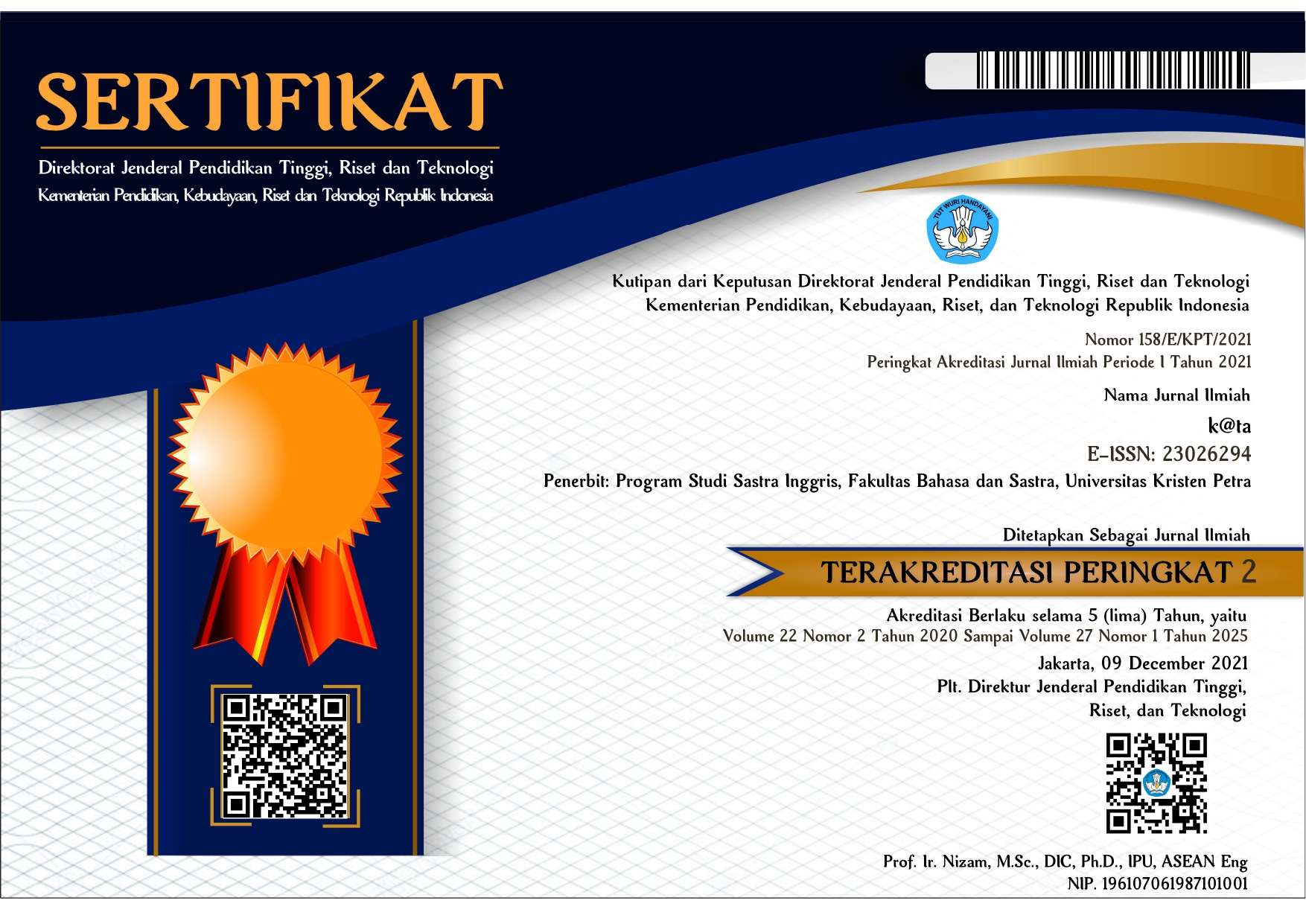Unfolding a Unique Tongue: A Morphological Formation of Swardspeak in a State University
DOI:
https://doi.org/10.9744/kata.27.1.34-47Keywords:
Gay lingo, Key rules, Morphological formation, SwardspeakAbstract
Swardspeak is a unique language with distinct linguistic characteristics. This study examined the morphological formation processes of swardspeak or gay lingo, utilized in a state university. Using qualitative research, specifically discourse analysis, the morphological formation of the swardspeak used by gays at Quirino State University was investigated. The study included 80 participants who were identified as gay guys and enrolled from the three campuses, along with two gay interraters and a language teacher who assisted with data processing. The study gathered the participants' gay lingo, which served as data to examine its morphological formation processes. The findings revealed that key rules are employed in each morphological formation process, such as acronym, blending, borrowing, clipping, clipping with affixation, coinage, compounding, derivation or affixation, association, and substitution. Recognizing the specific morphological rules and incorporating various languages into their swardspeak increases the sense of belonging and shared identity among gay individuals at Quirino State University.
Downloads
References
Abd Rahim, N. (2018). Discourse analysis theory: A new perspective in analysis. Infrastructure University Kuala Lumpur Research Journal, 6(1), 46–53.
Amante, I. (2021). Semiotic analysis on gay lingo expressions. Asian Journal of Advanced Multidisciplinary Researches, 1(1), 1–4. https://msubuug.edu.ph/journal/vol1issue1/AJAMR032021003.php
Budasi, I. G., & Bhuwana, I. P. A. (2020). Analysis of slang words formation found in the lyrics of Drake’s Songs. k@ta, 22(1), 10–16. https://doi.org/10.9744/kata.22.1.10-16
Cage, K. (2003). Gayle: The language of kinks and queens : A history and dictionary of gay language in South Africa. Jacana Media.
Cantina, J. M. (2020). Gay argot: Beyond the coded words and meanings of lavender lexicon. International Review of Humanities and Scientific Research, 248–262.
Casabal, N. V. (2008). Gay language: Defying the structural limits of English language in the Philippines. Kritika Kultura, 0(11). https://doi.org/10.3860/kk.v0i11.754
Cong, D., & Silitonga, R. (2018). The slang in the Gay Best Friend Movie by using syntactical analysis. Jurnal Basis, 2(2), 99–110. https://ejournal.upbatam.ac.id/index.php/basis/article/view/313
Cortez, H. V. (2017). Gay language: Impact on colloquial communication in Barangay Sto. Tomas, City of Binan Laguna. Journal of Social Sciences (COES&RJ-JSS), 6(2), 375–382. https://doi.org/10.25255/jss.2017.6.2.375.382
Co-Tortogo, L. M., Samson-Caraballe, M. R., & Montalvo-Pedrosa, E. (2021). Hiligaynon-Visayan gays’ spoken discourse: A morphological analysis. Globus Journal of Progressive Education, 11(2), 73–81.
Creswell, J. W. (2012). Educational research: Planning, conducting and evaluating quantitative and qualitative research (4th ed.). Pearson Education, Inc.
Crisol, L. G. D., & Parungao, L. A. (2016, May 20-21). A study on the secret language of the Mochas in Iligan City [Conference presentation]. International Conference on Research in Social Sciences, Humanities and Education (SSHE-2016), Cebu, Philippines. https://uruae.org/siteadmin/upload/UH0516053.pdf
Dacanay, L. R. (2014). Development of the third gender linguistic variation. UV Journal of Research, 8(1), 249–256. https://core.ac.uk/download/pdf/230830416.pdf
Dang, T. H. (2013). A preliminary study of gay spoken language in Ho Chi Minh City. Language in India, 13(9), 448–467.
Dayon, C. (2017). Morphosyntactic features of English variety in Davao City, Philippines. The ASTR Research Journal, 1(1), 23–39. https://aseanresearch.org/downloads/astr/publication/DAYON.pdf
Kinyua, G. K. (2017). A lexical–semantic analysis of the language of the lesbian, gay bisexual and transgender communities in Nairobi city county, Kenya [Unpublished doctoral dissertation]. Kenyatta University. https://ir-library.ku.ac.ke/handle/123456789/18350
Nuncio, R. V., Pamittan, G. B., Jr., Corpuz, D. R., & Ortinez, E. V. (2021). Jokla and jugels: A comparative analysis of the construction of popular and Hiligaynon gay words. Humanities Diliman, 18(2), 37–64. https://journals.upd.edu.ph/index.php/humanitiesdiliman/article/view/8538/7476
Oficiar, J. E. (2019). Language of homosexuality: A morpho-semantic analysis. International Journal of English Language and Linguistics Research, 7(5), 1–18. https://eajournals.org/ijellr/vol-7-issue-5-october-2019/language-of-homosexuality-a-morpho-semantic-analysis/
Pandong, K. (2015). Morphological structure of gay language in Central Mindanao University [PowerPoint slides]. Emaze. https://www.emaze.com/@AIIIOCTL/Morphological-copy1
Papua, A. J., Estigoy, M. A., & Vargas, D. (2021). Usage of gay lingo among millennials as a way of communicating. SSRN Electronic Journal. https://dx.doi.org/10.2139/ssrn.3794691
Pascual, G. R. (2016). Swardspeak (gay lingo) in the Philippine context: A morphological analysis. International Journal of Advanced Research in Management and Social Sciences, 5(12), 32–36.
Plag, I. (2003). Word-Formation in English. Cambridge University Press.
Romero, G. R. L. O. (2022, May 12-13). AbakaBadaf: Reclamation of queer spaces and the adoption of gayspeak by the mainstream [Conference presentation]. 4th DLSU Senior High School Research Congress. De La Salle University, the Philippines. https://animorepository.dlsu.edu.ph/conf_shsrescon/2022/arts_da/3/
Rosales, H. E., & Careterro, M. D. (2019). Stylistics variation: Understanding gay lingo in social perspectives. The Normal Lights, 13(1), 1–24. https://doi.org/10.56278/tnl.v13i1.1240
Silvano, M. M. P. (2018). Morphosyntactic analysis of the Tandaganon gay language. International Journal of Recent Advances in Multidisciplinary Research, 5(8), 4042–4050. https://ijramr.com/sites/default/files/issues-pdf/xx2159.pdf
Susandi, N. K. A., Rusanti, N. P., & Sutrisna, I. P. G. (2018). Gay language in Bali (sociolinguistics study on homosexual and bisexual men in Bali). In In Djatmika, R. Santosa, M.R. Nababan, Sumarlam, M. Z. Sulaiman, T. Wiratno, H. Ardi, B. Budiharjo, H. R. Pulungan, Ilham (Eds.) Proceedings of the Fourth Prasasti International Seminar on Linguistics (Prasasti 2018) (pp. 204–212). Atlantis Press. https://doi.org/10.2991/prasasti-18.2018.38
Taylor, S. (2013). What is Discourse Analysis? Bloomsbury Publishing.
Szymanek, B. (2005). The latest trends in English word formation. In P. Štekauer, & R. Lieber (Eds.), Handbook of Word Formation (pp. 429–448). Springer. https://doi.org/10.1007/1-4020-3596-9_17
Ulla, M. B., Macaraeg, J. M., & Ferrera, R. E. (2024). ‘What’s the word? That’s the word!’: Linguistic features of Filipino queer language. Cogent Arts & Humanities, 11(1), 1–14. https://doi.org/10.1080/23311983.2024.2322232
Yule, G. (2010). The study of language (4th ed.). Cambridge University Press. https://doi.org/10.1017/CBO9780511757754
Downloads
Published
How to Cite
Issue
Section
License
Copyright (c) 2025 Analyn Daguro Almoite

This work is licensed under a Creative Commons Attribution 4.0 International License.
![]() This work is licensed under a Creative Commons Attribution License
This work is licensed under a Creative Commons Attribution License



.png)
.png)

















